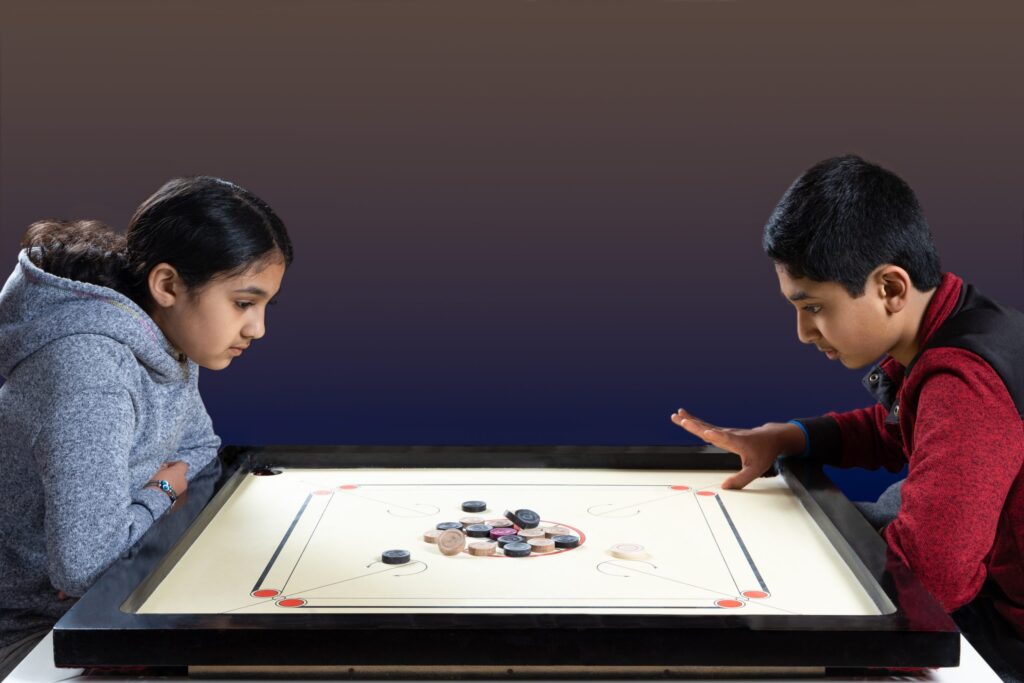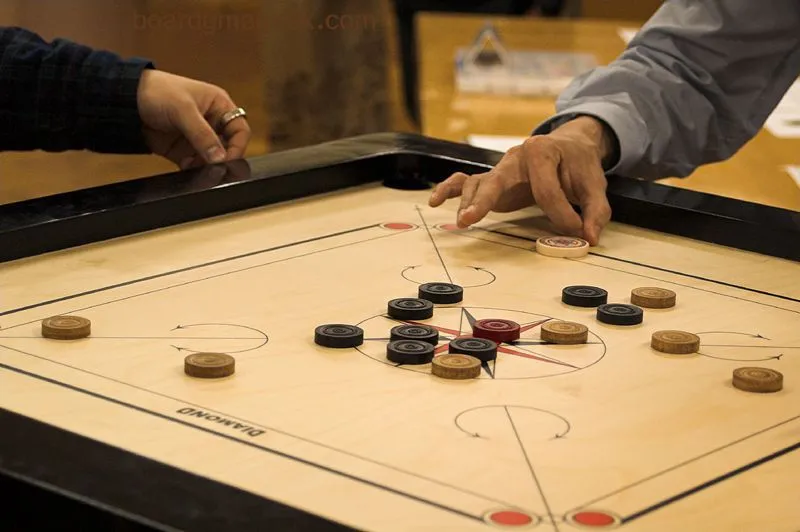Caram
The Rules of Carrom
Carrom or Karom is a game that has long been played throughout India and South East Asia but the game has become increasingly popular throughout much of the rest of the world during the last century. There are a huge number of variations in the rules even though an international regulatory body and several major national bodies exist – even these have rule variations depending upon the situation. Masters Games has based the following rules on those from the UK Carrom Club, tailoring them for simplicity where possible.

Equipment
The following dimensions vary considerably and are given only as an example of a tournament board. A Carrom board is a square smooth flat wooden board that can be 72cm or 74cm square and which should be positioned 60 – 70cm above the ground. In each corner is a circular hole that can be 51mm in diameter and underneath each hole is a net to catch the pieces in a similar way to a snooker table. Two lines are drawn on the table along the diagonals. These are the “foul lines”. In the centre are two concentric circles – the centre circle is the size of a piece, the main circle having a diameter about six times larger. Outside the circles and a short way in from each side of the board are two straight lines parallel with the edge of the board. They should be about 3.8cm apart and the long thin area between them is terminated just before the diagonal foul lines at either end by a red circle of 3.8cm diameter. This thin rectangle with circles at either end is called the “baseline” and the baseline nearest to a player is the area that the player’s striker must be played from.
There are nine dark or black pieces and nine light or white pieces plus a red piece called the “Queen”. The smooth wooden pieces are slightly smaller than the the striker which is between 3.8cm and 4.4cm in diameter. People often own their own strikers which can also be made of bone or ivory and which are normally somewhat heavier than the pieces although can vary in weight from half as heavy to four times as heavy as a piece. On some boards, potato starch, chalk dust or other lubricant is used to make the pieces slide more easily over the surface of the board – the most popular lubricant is boric acid.
Preparation
To decide who goes first, one player should hold a piece concealed in one hand. If the opponent guesses correctly which hand, the opponent chooses who goes first, otherwise the player concealing the piece chooses. The person who plays first aims to pocket the white pieces.
The game is played by two opponents sitting opposite each other. To begin, the Queen is placed in the centre of the board. Six pieces are put around the Queen directly in a circle, each touching the Queen and their neighbours. The remaining twelve pieces are positioned around the inner circle of six pieces, so that each outer piece touches the inner circle. Both circles should have the pieces alternating in colour. The two circles are oriented so that the Queen, a white piece from the inner circle and a white piece from the outer circle lie in a straight line pointing towards the centre of the side of the board where the player who will play first is sitting.
Objective
Players take turns to play. A turn consists of one or more strikes. A player wins by pocketing all of the pieces of their chosen colour first. However, neither player can win until one or other player has “covered the Queen”. To cover the Queen, a player must pocket one of her own pieces immediately after pocketing the Queen. If the Queen is pocketed but not covered, the Queen is returned to the board. Both players normally try to cover the Queen in addition to trying to win the game because a player who wins and also covers the Queen receives bonus points.
Striking
- For each strike, the player must position the striker within the baseline OR on one of the two circles at either end of the baseline.
- A striker within the baseline must touch both the front line and the rear line.
- The striker may not “cut the moon” – be placed partially within the baseline and partially within the circle.
- The player must flick the striker with one finger so that it crosses the front baseline – it is not permitted to flick backwards or horizontally.
- A piece that is on or behind the front baseline must not be struck by the striker until the striker has crossed the front baseline.
- In striking, the player’s hand or arm must not cross the diagonal foul lines at either end of the baseline.

Basic rules
- For the very first turn, the player is allowed three attempts to “break” i.e. disturb the central group of counters.
- It doesn’t matter which piece the striker hits first and it doesn’t matter if the striker hits no pieces.
- If a the striker pockets the Queen and/or one or more pieces of her own colour, the player retrieves the striker and takes another strike.
- If the player pockets no pieces or commits a foul, the turn finishes.
Covering the Queen
- A player may only pocket and cover the Queen if that player has already pocketed at least one piece of that player’s colour.
- Should a player pocket the Queen before being permitted to cover it, the turn continues but the Queen is returned to the centre at the end of the turn.
- If a player pockets the Queen and one of her own pieces in the same turn, this counts and that player has covered the Queen. Such a player must have already pocketed at least one piece in order to cover the Queen as per normal.
- When a player pockets the Queen but does not cover it, the Queen is returned as near as possible to the centre circle by the opponent.
Other Rules
- Pieces returned to the centre can be placed on top of other pieces within the main circle.
- If pieces come to rest standing on their edge or overlapping another piece, they are left as they are until moved again in the normal course of play.
- If the striker comes to rest under another piece, the striker should be removed with as little disturbance to the covering piece as possible.
Fouls
When a player commits a foul, the turn comes to an end immediately and a penalty is incurred. The penalty is that one pocketed piece is returned to the board by the opponent anywhere within the main circle. Any other pieces requiring to be returned to the board are also placed within the main circle by the opponent. It is normal for pieces to be positioned in order to confer an advantage for the opponent.
A foul is recorded in the following situations:
- The striker is pocketed.
- The striker or any other piece leaves the board.
- A player pockets an opponent’s piece. If the Queen was also pocketed, it is returned to the centre by the opponent together with the penalty piece. Any other pieces pocketed in the same strike remain pocketed.
- A player pockets the final opponent’s piece. Regardless of whether the Queen has been covered, the opponent’s piece is returned to the centre in addition to the penalty piece.
- A player pockets the final piece before the Queen has been covered. In this case both the pocketed piece and a penalty piece are returned to the centre.
- A player contravenes the rules for striking.
- A player touches any piece in play, other than the striker.
- The first player to strike fails to break the counters in three attempts.
Where a penalty is incurred but no pocketed pieces exist to return, the penalty is “owed” until a piece becomes available. If a penalty is owed, when a piece becomes available due to being pocketed, the piece is returned to the centre by the opponent at the end of the turn. Should the opponent forget to do this before the start of the next turn, any owed penalties are lost.
Scoring
At the end of the game the winner scores 1 point for each opponent’s piece left on the board. If the winner also covered the Queen, a bonus 5 points are scored. The maximum score for one game is therefore 14 points.
A match is usually played to 29 points and for matchplay, if the winner’s score has reached has 24 or more points, then 5 bonus points are NOT added for covering the Queen.
Doubles
Carrom is played by four people just as often as by two. For the doubles game, partners sit opposite one another and turns proceed in a clockwise order. Other than that, play is exactly the same as for the singles game. The game has a different character, though, because pieces behind the baseline can be safely left for the partner to deal with unlike in the singles game where pieces behind the baseline can only be moved by the opponent or by rebounding of the board edges.
